“Buckle up!” the world seems to be saying, “because the ride is only going to get bumpier.”
Indeed, we have already experienced three years of the most turbulent times in recent history. The global pandemic, spiking inflation, and near-recession have fueled several new challenges for leaders. In addition to their traditional responsibilities, today’s leaders must deal with trends such as the “Great Resignation,” “Quiet Quitting,” and “Bare Minimum Mondays.” Likewise, they must figure out how to handle the dramatic changes that likely will result from emerging technologies such as ChatGPT and other artificial intelligence-based tools. All this while piloting their employees and organizations toward optimum performance.
This year’s Annual Leadership Development Survey shows a distinct search for the next pattern of success. Over the last six years that Training magazine and Wilson Learning Worldwide Inc. have teamed up to conduct a survey exploring the steps organizations are taking to develop effective leaders, we averaged just under 700 responses each year. This year, more than 2,200 Learning and Development (L&D) professionals completed the survey, a clear mark that something is different! We saw some tremendous swings in needs and expectations and a clear indication that L&D, as an industry, is exploring new avenues and methods of effectively delivering leadership development training.
INVESTMENT IN LEARNING
Training and development spending per employee has seen large fluctuations over the seven years of the study. This past year saw one of the most significant increases in spending (+27 percent) after one of the larger decreases in 2021 (-18 percent). On average, companies spent about $183 per employee on training.
Despite the increase in training expenditures overall, we saw a decrease in the percentage of the training budget allocated to leadership development. Graph 1 shows that more organizations spent on the lower end (0 to 20 percent of the training budget) and fewer on the higher end (31 to 100 percent).
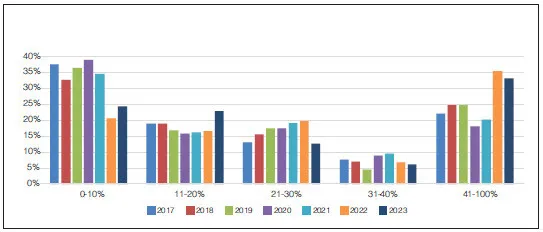
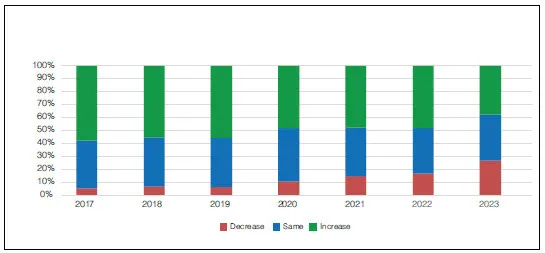
PRIORITY SKILLS
We asked organizations to identify their top five priority leadership skills. Graph 3 shows the change in the rank order. This year we saw the greatest number of changes from the last six surveys. While coaching and communication skills have remained the #1 and # 2 ranked skills for all seven surveys, overall, 11 of the 18 skills changed rank. Diversity and inclusion had the biggest change, dropping back to its lowest rank of 12th from the 2020 survey. The largest increase in priority was for change leadership, rising from 9th to 6th.
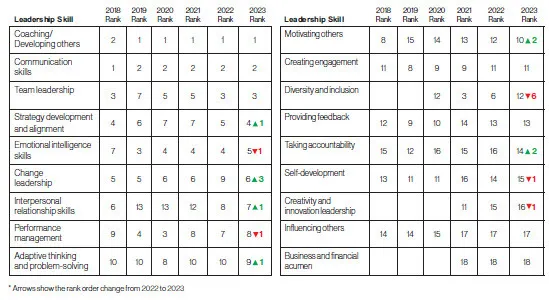
LEADERSHIP CHARACTER
We also saw one of the greatest increases in the number of organizations offering programs on character development (Graph 4). The percentage of organizations providing a program specific to leadership character development has more than doubled, going from 18 percent in 2020 (the first year of the question) to more than 38 percent this year. Overall, 78 percent of organizations offer some form of leadership character development.

Integrity/ethics has remained the most important character element, but its prominence showed a sharp decline (Graph 5) In past years, 70 to 90 percent of respondents saw integrity and ethics as the highest priority, but this year only 51 percent did so. We saw a leveling out of ratings—all top five character elements showed a decline. Where has priority shifted? Openness and connectedness were the only two character elements that showed an increase.
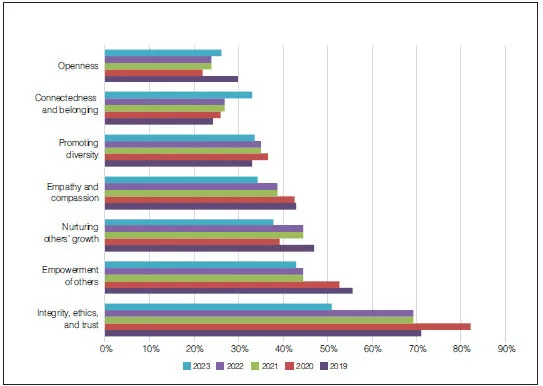
WORK ENVIRONMENTS
One of the widespread impacts of the pandemic has been the increase in remote and hybrid work environments. In last year’s survey, the trend was toward either 100 percent remote or 100 percent at the work site. This year, hybrid work environments was the only category to increase (nearly 32 percent in 2023 versus 27 percent in 2022). When asked how the new hybrid work environment is affecting leadership development, 56 percent indicated that the impact has been positive, while only 36 percent said it was negative (see Graph 6).
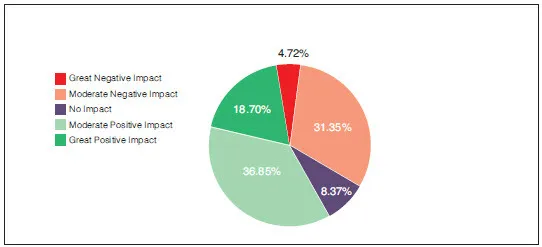
It also seems organizations are taking different paths to leadership effectiveness. Organizations are almost evenly split on how they are delivering leadership development, with the largest group (38 percent) creating a new hybrid/blended learning approach combining classroom, virtual classroom, and digital training, followed closely by those transitioning almost exclusively to virtual classroom training (36 percent). Only 24 percent have returned to in-person classroom training at pre-pandemic levels.
LEARNING APPROACHES
In previous surveys, we found that the percentage of organizations using different learning methods had not changed significantly. That was not the case this year. All 24 methods showed an increase in the number of organizations using them. The five methods that increased the most are shown in Graph 7—there was a noticeable uptick in technology-focused delivery methods such as virtual and augmented reality, artificial intelligence, open-source programs, and social media.
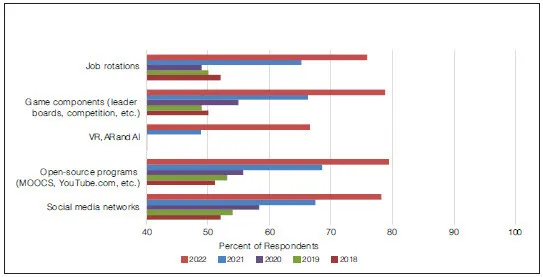
Unfortunately, those five methods that increased in usage the most were among the lowest in effectiveness. The most effective methods were structured on-the-job training, simulations and role-plays, instructor-led classroom training, reinforcement and review after training, and blended learning.
BEST PRACTICES OF HIGHLY EFFECTIVE ORGANIZATIONS
A large part of searching for patterns is the effort to find what works. To help in this, every year, we include measures of leadership development effectiveness. Using these measures, we divide the responses into three groups: high-, moderate-, and low-performing organizations. This method allows us to benchmark the differences between high- and low-performing organizations.
Benchmarks for performance are useful guides for making improvements. Through our research, we identified outcomes that define leadership effectiveness. These six indicators are measures of leadership development impact that experts agree provide a good indication of leadership development performance.
- Leadership is a source of competitive advantage: Do senior executives acknowledge the importance of leadership development to the organization’s success?
- Best-in-class leaders: Are other companies trying to recruit their leaders away?
- Attracting high potentials: Does the organization’s approach to leadership development attract high-potential leaders from other companies?
- No leadership gaps: Does the organization have significant gaps in leadership capacity?
- Sufficient resources: Do organizations have the necessary resources to effectively develop their leaders?
- Sufficient leadership bench strength: How satisfied is the company with its ability to replace departing leaders?
By combining these six measures and then ranking organizations from high performing to lower performing, we create one measure of overall leadership effectiveness.
DIVERSITY AND INCLUSION
Few leadership skills have seen as much volatility as diversity and inclusion (D&I). Over the last four years, its ranking in importance by respondents has gone from the 12th most important (of 18 skills) to the third most important and now back to the 12th most important skill this year.
We wanted to take a closer look at what organizations are doing to improve D&I within their cultures. We found some critical differences between high-performing and lower-performing organizations in how they approach D&I and the impact it has had on the organization. Graph 8 shows how organizations approach D&I from a leadership development perspective. More than 45 percent of high-performing organizations have specific leadership programs on D&I. This contrasts with only 26 percent of low-performing organizations. Overall, 90 percent of high-performing organizations provide some form of D&I training versus less than 60 percent of low-performing organizations.
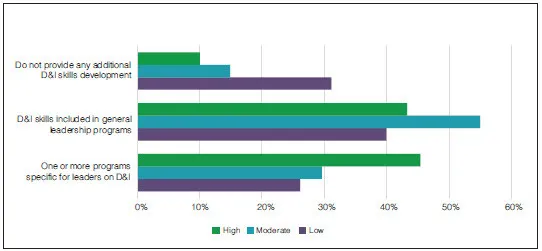
For high-performing organizations, these actions have resulted in significant improvements in leadership and diversity. Graph 9 shows that 90 percent of high-performing organizations agree or strongly agree that these programs have resulted in improvements, compared to only 43 percent of low-performing organizations.
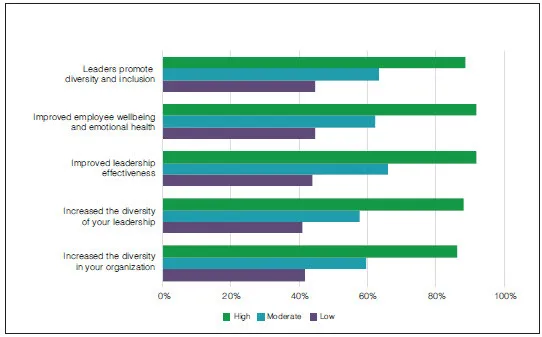
RESPONSIBILITY FOR DEVELOPMENT
Last year, we saw an increase in the number of organizations expecting leaders to take personal responsibility for their own development. Overall, 70 percent of organizations have this expectation. However, a differentiating factor between high-and low-performing organizations is the level of support they provide to new leaders in accepting this responsibility. Graph 10 shows high-performing organizations support this effort by providing 360-degree assessments, making leadership development a key performance indicator (KPI), and using stretch assignments to guide development choices.

GENERATIONAL SHIFT
Particularly among high-performing organizations, we saw a shift in the generation leading the organization. As Graph 11 shows, in high-performing organizations, Generation Z and Millennial leaders outnumber Generation X and Baby Boom leaders. The reverse is true for lower-performing organizations, where Baby Boom and Generation X outnumber Millennial and Gen Z leaders.
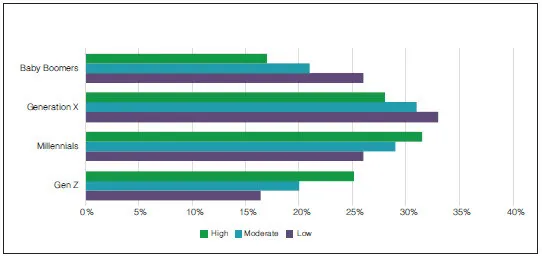
Given this shift, the involvement of both new and current leaders in leadership development is critical. Current leaders of high-performing organizations are more likely to let go of responsibilities and provide coaching and support. In addition, next-generation leaders in high-performing organizations have a commitment and passion for leadership, recognize the need for development, and have reasonable expectations for their careers (all above 80 percent for high-performing organizations versus less than 60 percent for low-performing ones).
TIPS AND TAKEAWAYS
Organizations will continue to navigate the changes they encounter during this disruptive period. Therefore, one of the key requests we made this year was to ask people to share with the community their best practices, tips, or lessons. More than 900 respondents shared their ideas, with many echoing the outcomes of this survey. The best practices and the results of this survey suggest several actions organizations can take to strengthen their leadership development efforts:
- Right-size your investment in leadership development. If your investment in leadership development fluctuates from year to year, it is difficult to set and support long-term objectives. Many of the success measures for leadership development take time to change, and the more effective organizations acknowledge that a more stable investment strategy helps you achieve success—and they point to executive involvement as a key factor.
BEST PRACTICE: “Executive buy-in and the ability to demonstrate value and return on investment are key. Understand your business burning points and leadership gaps, and show how the leadership program is aligned to company success. Ensure your leadership development program speaks the business language.”
- Prioritize leadership character development. While leadership character may not be trainable, it can—and needs to—be developed. High-performing organizations incorporate character development into their leadership development at higher rates than lower-performing organizations do. The results in this report point to the value of looking at character more broadly—not just ethics and trust, but openness, connectedness, and belonging.
BEST PRACTICE: “People are people. Treat them as such. Emphasize that everyone is important and that a role in an organization is unrelated to a person’s worth as a human being. Treating others with empathy and compassion leads to better outcomes.”
- Examine hybrid leadership. The pandemic fueled an already existing trend: the move toward a hybrid work environment. Many future leaders will be required to manage teams of hybrid workers, and few seem prepared. Leadership development programs must ad dress the new skills and mindsets needed to lead an increasingly remote workforce.
BEST PRACTICE: “Honestly, we have improved from what we were doing pre-pandemic. Prepandemic, we had folks who were not located in one of our offices (remote due to their location) and we often sort of ‘forgot’ about them when we planned events and meetings. Now everyone is remote, so we are more inclusive.”
- Choose the right learning methods for your organization. The broad swings in learning methods used by organizations indicate that many are searching for what works. Leadership is largely a social activity, and leadership development should mirror that. Unfortunately, many of the methods that grew in popularity were also seen as the most ineffective at changing leadership behavior. While seeking learning that provides “more bang for the buck,” organizations also need to consider the social nature of leadership development. High-performing organizations build multiple collaborative learning experiences into their leadership development, whether in person, remotely, or digitally.
BEST PRACTICE: “Bring the learning to the leader’s location and make it more personalized—which is a challenge to do. We have used a wide variety of different learning mediums; certain things work at certain times but not at others. The increased investment in personalized coaching has been the biggest change to date.”
- Sustain diversity and inclusion efforts. Two years ago, diversity and inclusion was the third most important leadership skill. This year, it was 12th. If we are to are to improve the leadership environment for our increasingly diverse work environment, we need sustained action and clear outcomes for what we are attempting to achieve.
BEST PRACTICE: “Foster a culture of diversity and inclusiveness. Building a cross-functional cohort of diverse participants helps reduce silos and empowers everyone with opportunities to gain greater perspective of the business as a whole.”
Today’s turbulent times can be viewed as a threat to leadership development effectiveness, but opportunity also is knocking. Now is the time to open the door wide and welcome aboard the innovation, experimentation, communication, and collaboration that will help leaders successfully guide their teams, employees, and organizations boldly and inclusively into the future. The flight may not always be smooth, but the destination is definitely worth the effort.
SURVEY METHODOLOGY
More than 2,200 Learning and Development (L&D) professionals responded to the 2023 Leadership Development survey. Overall, in the seven years of the survey, we have collected data from more than 6,000 professionals. All were employees of companies that create and use leadership development services with their own employees; we exclude external providers of learning and development services from the results.
The majority of respondents (74 percent) had management responsibility, with the largest groups having titles of VP or higher (23 percent), Manager (31 percent), or Director (20 percent).
Most respondents (63 percent) operated only in the United States; the remaining were composed of multinational (26 percent) and global (12 percent) companies. Organizations were evenly distributed in company size, ranging from less than 100 employees to more than 50,000, with the largest group (18 percent) having 1,000 to 5,000 employees.

